Particle Problems and How to Solve Them
This week, we're journeying into the world of the smallest objects known to humanity: the tiny particles that make up us and the entire universe around us. Plus, in the news, getting the world vaccinated against COVID-19 - half the global population have been jabbed so far, but the many countries in the Global South lag far behind; the Nobel prizes are announced; and, have scientists finally solved the biggest problem of them all: leaves on the line delaying trains...
In this episode
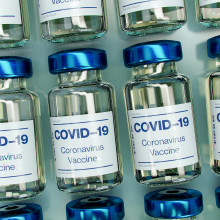
01:02 - COVID vaccine equity: protecting the world
COVID vaccine equity: protecting the world
Richard Hatchett, Coalition for Epidemic Preparedness Innovations
The good news is that half the world's population have now had at least one dose of a COVID-19 vaccine. That's an outstanding achievement. But the bad news is that the picture looks a lot less rosy when we focus exclusively on some countries in the global south, where literally a few percent of the population of each country have been vaccinated so far. Apart from the obvious threat to life there, this matters to all of us, because high disease turnover in a population increases the likelihood of further COVID variants emerging that can threaten everyone. But, as Richard Hatchett, CEO of CEPI - the Coalition for Epidemic Preparedness Innovations - one of the organisations working to solve the present situation, explained to Chris Smith, the low vaccination rates are not because of a lack of vaccines; it's how they're being distributed that we need to pay attention to and plan for…
Richard - Vaccine production globally is scaling up with astonishing rapidity. We've already delivered over 6 billion doses of vaccines. There are some estimates that by the end of the year, we may even get to 11 or 12 billion doses of vaccine being distributed globally. So that would potentially be enough to vaccinate five and a half or 6 billion people. The problem is that countries have different capabilities, different resources to receive and deliver that vaccine. And so I think we may very rapidly move from a situation where the global vaccine situation was characterized by scarcity to one in which the rate limiter is how quickly can countries receive and then deploy and dispense that vaccine to their populations and poorer countries with less developed public health systems are going to face the greatest challenges
Chris - Are all the vaccines fit for purpose in all places though? Because we've struggled in the UK, at least initially, to get the Pfizer vaccine deployed because the demands of keeping that vaccine at minus 80 degrees were really very extreme. So that means that that's not going to be a useful vaccine for a resource poor setting where they don't even have a fridge let alone electricity to run that fridge. So have we got the right sorts of vaccines fit for purpose, for deployment into resource poor settings?
Richard - Well, we've used a number of technologies to develop the many vaccines that we now have. And, and you're right. Some vaccines like the MRNA vaccines do have cold chain requirements, where you have to keep them cold the entire time, almost until the point that you put the vaccine into a person's arm. Vaccines with complicated logistical requirements, present added challenges, even poor countries have some ability to receive and use even vaccines like the Pfizer and Moderna. But you're exactly right. If that vaccine presented a challenge in the UK, you can imagine what kind of a challenge it would present in Chad or the democratic Republic of Congo or Somalia. Some of the vaccines are easier to use and what we're trying to do. We have many, many vaccines coming into COVAX, and we're trying to match the vaccines to the countries as well as we can, but it's a huge challenge.
Chris - The other thing that we've considered here in the UK is what to do about boosters and whether or not just giving two doses of the same thing, a certain period of time apart, is best practice? And obviously it's a learning process and we're learning all the time. So what mechanism is being used when we give these vaccines to other countries in order to make sure that they actually use them most optimally?
Richard - I would say on the whole, the rush that many high-income countries are in providing boosters to their entire population is a concern because every dose that is allocated to providing a booster dose is potentially a dose that is not being provided to provide someone a first dose. And what we know, even the incremental value that the boosters provide in terms of protecting people is not greater than the value that a first and second dose would provide to somebody who has not been vaccinated at all. So we have called for prioritizing the existing supply of vaccine to make sure that people who have not been vaccinated at all can have access to vaccines before we start providing boosters to the vaccinated population
Chris - And with your crystal ball in your hand, how do you see this playing out over the next 12 months? Where do you see us if we're talking together at this time next year, where are we going to be?
Richard - The United States and the WHO have both set an aspiration for a global level of vaccination to reach approximately 70% by this time next year, that's a hugely ambitious aspiration. There are many countries that have barely begun to vaccinate their populations and are going to face substantial logistical challenges in accomplishing that goal. I think we will have enough vaccines globally to accomplish that goal by this time next year, whether we will have been able to package that vaccine up, deliver it and get it out to people remains to be seen. And I think that will only be accomplished if there is a very substantial, coordinated global effort led by countries that have resources like the UK, the US, and European partners to make sure that that happens.

06:43 - 2021 Nobel Prize in Physiology or Medicine
2021 Nobel Prize in Physiology or Medicine
The 2021 Nobel Prizes have been announced so we’re going to visit each in turn, and here’s Sally Le Page with a spicy story to kick things off…
Sally - The Nobel Prize in Physiology or Medicine this year goes to... curry. Well, okay, not quite, but it does recognise the discovery of the science that explains why a vindaloo sets your mouth alight.
This is down to how the nervous system decodes and transmits information about temperature, pain and touch, which is what winners David Julius and Ardem Patapoutian have spent their careers trying to figure out.
When we run our fingers over a rough surface, delve into our pockets to find a key or a coin, or dip a tentative toe in the water at the beach to tell how warm it is, specialised structures called "receptors" on nerve endings in the skin respond by firing off barrages of electrical impulses to tell the brain what's going on.
The challenge was to discover the identity of those receptors and, ultimately, how they work. If we can do that, and find the genes that the body uses to produce and control them, then we can potentially unlock new ways to treat conditions like chronic and acute pain, and the sensory loss that accompanies diseases like diabetes.
David Julius turned to chilli peppers to help him on this quest. These contain the spicy chemical capsaicin. When we eat this, it activates a family of nerve cells that respond to changes in temperature, fooling our mouths into thinking they are much hotter than they are so we experience a burning sensation.
By painstakingly adding genes one by one to cultured laboratory cells, David Julius eventually found the one that made his cells light up in the presence of capsaicin and, interestingly, the venoms of some spiders, explaining why spider bites often burn too. He then used the same trick to find the structures that respond to menthol and make your mouth feel cold when you suck a mint.
Ardem Patapoutian also independently found this menthol factor and at the same time discovered how nerve cells respond to touch. Like David Julius, he added genes one by one to cultured cells. Eventually he stumbled on a pair of genes, which he named Piezo1 and Piezo2, that made his cells produce bursts of electricity when he prodded them with a small pipette. They turned out to play a crucial role in how our bodies detect the positions of our joints.
So next time you reach for the spice jar, thank Ardem Patapoutian and David Julius for explaining how we know we're making those movements and how we appreciate the taste of the results...
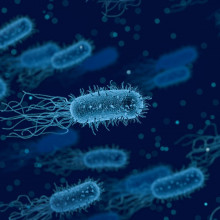
09:53 - Prostate cancer and the microbiome
Prostate cancer and the microbiome
Vincent Gnanapragasam, University of Cambridge
The human gut is stuffed full of microbes, many of them essential for our health, but new research suggests that they can also undermine the effectiveness of some treatments for prostate cancer. Prostate cancer is a very common condition, but it can often be controlled, at least for a while, with drugs to block the production of the male hormone testosterone, which acts as a growth signal for the cancer. But, in some patients, this treatment stops working, and a new study suggests this might be because their gut microbes start to make testosterone-like signals instead. Vincent Gnanapragasam took Eva Higginbotham through it - he wasn’t involved in the study but is a urologist specialising in prostate cancer at Cambridge University...
Vincent - So actually this idea that the gut microbiota may contribute to prostate cancer has been around for a little while, but in this study, what they did was to really go into the details of how this might be possible. So in effect, what they did was they studied mice and they looked at the microbiota or the organisms that grow in the bowels of these mice, in different models with and without treatment with androgen deprivation, which is to say, to block the male hormone. And what they found was that these bacteria within the gut could actually make some of the male hormones, or at least some of the precursors of the male hormones. And by changing that microbiota, you could actually alter how much male hormones that they produce in a situation where you wouldn't expect it to find particularly where the male hormones had been ablated or blocked by other means. They went further to show that you could identify specific bacteria, which is present, might predict that these mice and actually in patients as well, they might do better or worse from the treatment. So they came up with something they called bacterial fingerprints. And this work is obviously at a very early stage, but this provides a very interesting idea about how perhaps antibiotic treatments and things like that may be useful, particularly in advanced stages of disease.
Eva - Do we know why a bacterium or bacteria might make testosterone like signals in the first place? Does it play some role for them too?
Vincent - That's a very good question. And of course it's sort of counterintuitive to think about single cell organisms being able to biosynthesize or make these complex molecules. And I suspect that it's got to do with an underlying enzymatic reaction, which wasn't supposed to do that. But of course we have evolved over generations and thousands of years to live with these organisms. In many ways, we are a symbiosis of different organisms together with ourselves and diet comes into why people need to have different types of organisms. So I don't think we quite know why these specific organisms do this in terms of what's beneficial to them. And that is not what they address within this study, but it's clear that somehow these organisms have grown to live within us to produce these things, which obviously we didn't know about until, until we looked for it.
Eva - And what is it about having testosterone that prevents the treatment from working?
Vincent - So in this particular study, they looked at patients who were really in a sense gone through the standard therapies and failed and where castration or the blocking of the male hormones is the only therapy that's really viable. And the idea is by using drugs or surgery is to remove the male testosterone that causes prostate cancer to shrink, but something which has been come into the awareness of urologists and oncologists for many years is that there seems to be a basal level produced by other mechanisms, which were bypassing the so-called standard castration. So in fact, at one time we used to call it hormone refractory, and now we call it castrate refractory, which means to say that there are mechanisms producing these androgens despite the standard treatment. And it's these low levels of androgens, which seem to be still driving the prostate cancer, even when we think the conventional mechanisms should be working and that we found was happening with things from the adrenal glands. And so we found drugs to try to target that. And now this, this research, and in fact, previous research has suggested that even the bugs within our gut can also produce this.
Eva - Then just very briefly, does that mean then that we might give antibiotics to people with prostate cancer who don't seem to be responding to the treatment?
Vincent - I think it's an idea. It's a possibility. This is very early stage research, but certainly a promising avenue to investigate in the future.

15:06 - 2021 Nobel Prize in Physics
2021 Nobel Prize in Physics
Iacopo Russo reports on the winners of the 2021 Nobel Prize in Physics...
Iacopo - The Nobel Prize in Physics this year was all about the climate and other complex systems.
One half went to Syukuru Manabe and Klaus Hasselmann, for their contribution to the way we understand the Earth’s climate and its recent changes. We all know that the Earth is heating up because of carbon emissions, but it was thanks to Manabe’s models that we discovered the link between carbon dioxide concentration in the atmosphere and temperature. Very few people today would dispute that human activities are contributing to heating the planet’s atmosphere; well, Hasselmann was the first to establish that natural factors are not enough to explain global warming, and that humans are responsible, too. Overall, their work laid the foundations for all the models that are now helping us predict how a complex system like the climate will evolve in the next decades.
The other half of the prize, instead, went to Giorgio Parisi, for the theories he developed on disordered materials and random processes. Many problems in physics deal with systems made up of a lot of elements that interact with each other in random ways: the weather, for example, or the human brain, or even a flock of starlings. Parisi found a way to describe mathematically the hidden structure behind a complex system. His discoveries make it possible to understand and describe many different materials and phenomena that appear to be entirely random, not only in physics but also in other areas, such as mathematics, biology, neuroscience and machine learning.
The chair of the Nobel Committee for Physics highlighted how the discoveries recognised this year demonstrate that our knowledge about the climate rests on a solid scientific foundation, based on a rigorous analysis of observations. These scientists have helped us get a deeper insight into the properties and evolution of complex physical systems.

17:10 - New tech to stop rail delays
New tech to stop rail delays
Roger Lewis, University of Sheffield
We’re well into Autumn now which often ushers in a perennial problem: leaves on the line and delayed trains. It seems bizarre that something as mundane and fragile as leaves can bring public transport to a halt in the 21st Century, but it is a serious problem. Tannins in leaves react with iron in the rails to produce a super-slippery surface that the train wheels slide over. Thankfully, mechanical engineers at the University of Sheffield may soon be riding to our rescue with a way to make this commuting catastrophe a thing of the past. Sally Le Page reports…
Train announcment - We are sorry to announce that the 1822 train to Cambridge has been delayed due to leaves on the line. We are sorry for any inconvenience caused.
Sally - Ugh, the announcement we all dread to hear. But leaves? Why are high-tech trains in the 21st century thwarted by leaves? Roger Lewis explains.
Roger - Every autumn as the leaves are falling from the trees, these are crushed by the passage of trains and you get some chemical reactions taking place in the interface that create this black material that adheres to the railway track very well. You'd find it very hard to scratch it off even if you were poking the track with a screwdriver or a metal blade, which means that trains struggled to brake safely, but also to accelerate away from stations which causes delays and makes passengers unhappy.
Sally - So the leaves are chemically bonded to the track. It's not just like when I'm walking on the pavement and the leaves are all wet and mushy, it's a bit slippy. It's more than that.
Roger - It is more than that.
Sally - And how do we currently deal with them?
Roger - So at the moment, network rail use what are called railhead treatment trains, which fires water at the rail head under very, very high pressure. The pressure is so high that if the train stopped and the water kept going, it could possibly cut through the rail.
Sally - Cut through solid steel?
Roger - Yeah.
Sally - That is incredibly high, and must use a lot of water as well.
Roger - It does. This is one of the problems with the trains. They can only run a certain distance before they need refilling.
Sally - So your solution involves using dry ice. What is dry ice, other than the thing you put in fancy cocktails to make them go all smoky?
Roger - The pellets we use are basically solid carbon dioxide. Now that sounds very bad. We don't like carbon dioxide at the moment, but actually all the carbon dioxide we use is recaptured from other industries that are putting it out into the atmosphere. So most of it comes from the fertiliser industry. Basically you have to compress it under very high force so that then it turns into a solid. Then you have to keep it very cold to keep it solid. So when it comes out of our machine and hits the railhead, it's at about minus 70 degrees centigrade.
Sally - How are you using dry ice to remove this slippy layer from the track?
Roger - We fire it onto the top of the railway track in a stream of air, which is actually going at supersonic speed. So you've got these pellets going at very high speed. Because they're cold they make the leaf layer brittle. And then because they're back in the atmosphere, they turn back into a gas. So you've got lots of little air explosions, almost, across the top of the railway track. So you've got three mechanisms there which are acting to break up and remove the leaf layer.
Sally - I'm imagining a machine gun firing continuously little ice pellets. Does it look anything like that?
Roger - That's kind of how it works, but that's not how it looks. It doesn't look as exciting as that, I'm afraid.
Sally - You've got these dry ice machine guns strapped to passenger trains. Can they just run as normal? Will this happen during the normal commute from London to Cambridge, or does the train have to be going particularly slowly for it to work?
Roger - That's a good question. At the moment, railhead treatment trains, for example, are designed to run at 60mph. A lot of passenger trains on local lines would typically run at that speed or a bit less. So we've obviously been targeting high speed operation. We were testing it on a full-scale wheel rail test at 60mph. We've run on track on a train at 40mph. And hopefully this autumn we'll be able to go a little bit faster. The good thing about cleaning on a passenger train is that hopefully we'll be able to stop the really heavy contamination building up. So if we can clean more frequently, we can do a lighter clean, which is obviously much easier at higher speed.
Sally - It's a bit like brushing your teeth often so you don't have to go to the dentist and get horrible treatments done.
Roger - Yes, quite.
Sally - And how long do you think it's going to be until we no longer have the dreaded announcement of "this train has been delayed due to leaves on the line"?
Roger - I'd like to say very soon. I think our systems will be underneath trains probably within a couple of years, but we can use it already on a railhead treatment train or road-to-rail vehicles. So we're already cleaning the track with it
Sally - And it can't come soon enough. Now, when is that next train arriving?
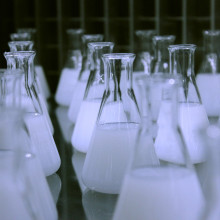
22:51 - 2021 Nobel Prize in Chemistry
2021 Nobel Prize in Chemistry
Eva Higginbotham reports on the 2021 Nobel Prize in Chemistry winners...
Eva - Next up on the roster was the Nobel prize for chemistry, and this year it was awarded for a process called asymmetric organocatalysis.
This allows chemists much greater control over the molecules they produce. You see, some molecules exist in two forms, They are almost identical except reversed, just like our hands, it would appear that they are mirror images of each other.
Interestingly, these mirror-image (or chiral) molecules can behave in different ways. Let's take limonene as an example, this hydrocarbon is found in the peel of citrus fruits. It is commonly used for pharmaceuticals and for flavouring in the food industry. One form of the limonene molecule our noses detect as having a lemon scent, while the mirror image smells like orange.
As well as having different properties these mirror image molecules can also react differently in our bodies and so it is important to be able to produce only the desired form, especially for pharmaceuticals.
Benjamin List and Briton MacMillan were responsible for developing the technique of asymmetric organocatalysis back in 2000, a tool that makes it much easier to select the form of molecule desired.
The duo independently developed a brand new form of catalyst. A catalyst is something this is not used up in a chemical reaction but can make the reaction faster, cheaper, greener and in this case help select the desired molecule. Until 2000 it was generally assumed that, in principle there were only two types: metals and enzymes. These new organic catalysts are based upon a stable network of carbon atoms, and are environmentally friendly and cheap to make.
21 years later, the award committee deemed their findings practical implications, which range from pharmaceuticals to solar cells, worthy of a Nobel Prize.

25:25 - Viewing the hidden world of particles
Viewing the hidden world of particles
Tina Potter, University of Cambridge
This week’s topic is about the tiniest things in the universe that nevertheless have a massive impact upon us all; and yet, despite trillions of them coursing through our bodies right now, we all remain oblivious. So how do we know it’s even happening? Because we can see some of them with a gadget called a cloud chamber - a bath of extremely cold alcohol fumes in which, periodically, as particles arriving from space and elsewhere stream through, mysterious plumes and trails like shooting stars appear. Cambridge University physicist Tina Potter showed Cameron Voisey one in action...
Cameron - I'm looking at this big box and looking through a glass pane into this sort of black surface. On top, there are these wisps constantly changing, these white wisps, and some are super long and straight, some are very bendy, they curve here and there, even forming like U shapes or V's. And there's a crisscrossing and zigzagging all over the place. Tina, what am I looking at?
Tina - We have a fog there, essentially, a very cold fog. And when a particle travels across that fog, it disturbs it. You can think about it like a motorbike traveling through fog. It leaves this sort of disturbed path. So what you're looking at is the result of unstable nuclei inside the air. And what happens is those nuclei are unstable and they kick out a fragment of themselves or turn into something else. And those are electrons or positrons.
Cameron - So are these particles actually always around us?
Tina - Absolutely. They are all around you. You are radioactive as well. You are emitting a lot of these, but thank goodness, your skin is actually pretty good protection against the most damaging ones, and everything else your body has evolved to live alongside some of these radioactive decays. And the particles that come out, of course, are very, very important for things like gene mutations that are responsible for evolution and things like that. So actually particles and radiation are a fact of our world and are actually very beautiful, and necessary.
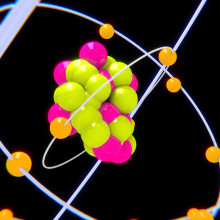
28:07 - The history of particle physics
The history of particle physics
Frank Close, University of Oxford
First up, let’s go back in time to understand where the fascination with particles began. Cameron Voisey heard from the University of Oxford's Frank Close...
Frank - The quest to understand what matter is made of goes back to the ancient Greeks who postulated that everything was made of atoms.
Cameron - That's Frank Close, Emeritus Professor of Physics at Oxford University,
Frank - And a century ago, that's what we thought the answer was - that the atoms of the elements, hydrogen, helium through to uranium, are what made everything. Since then, we know that atoms are not the smallest thing. They're made of smaller pieces - there's a central nucleus made of protons and neutrons around which circle tiny electrons. And so electrons, protons and neutrons are the basic constituents of all atoms. But in the last 50 years, we know that that isn't the final story (it's like peeling off layers of an onion), that although electrons appear to be basic seed to everything the protons and neutrons are made of smaller bits, little particles called quarks. So today the basic pieces from which all matter that we know of are made are electrons and quarks and particles of that sort.
Cameron - But is the end of the story? How many particles are there?
Frank - To make the world that we are familiar with, three are sufficient, but there are many more than that in practice. For some reason, nature wasn't satisfied with the basic set that make you and me, the stable things like the electron and the particular quarks that make protons and neutrons. It made two heavier versions involving things called muons, which are like heavy electrons, charmed and strange quarks, which are heavier than the ones that make protons and neutrons and top and bottom quarks, which are even heavier still. In addition to those, there are some ghostly, electrically neutral particles called neutrinos .
Cameron - The basic idea behind particle physics is to breakup objects until they can be broken up no more and then to study these things. The way these objects behave has far-reaching consequences, not only do they influence how things are constructed on the smallest scales, but on the bigger scales too. That's because the way particles behave in the early universe is responsible for how the universe looks today. That's one reason why it's so important we understand them. By piecing together lots of experimental information over the past half century physicists have been able to construct a theory of how these tiny little objects behave. It's called the Standard Model of particle physics. And it's one of scientist's most accurate and well-tested theories. Following a 50-year search, the final piece of this jigsaw was discovered in 2012 - the Higgs boson. The existence of this particle is a crucial part of the Standard Model and its discovery signals that the way particle physicists have seen the world up to now makes sense. So does that mean Frank's out of a job? Well, no.
Frank - We know a huge amount about 5% of everything. The reason being that the stuff that makes you and me is but flotsam on a sea of what's called Dark Matter. We know from the behavior of the galaxies, the way that the galaxies tug on one another, there's more gravitational pull than we can account for, than what we see through our telescopes . And so this dark stuff is called dark matter. There seems to be no real doubt that it exists, but what it consists of at the particle level, we don't know.
Cameron - And worse still, dark matter is just one member of a set of conundrums that keep particle physicists up at night. These problems range from the nuanced to the downright troubling. For example, according to the Standard Model, the universe should not just be made up of the matter that we're all familiar with. There should be an almost equal part of stuff called anti-matter, which actually annihilates matter when it meets. Where is this stuff? Well, while it does exist, there should be more of it than we're currently detecting. It's just one more sign that there must be something out there that we don't understand.
Frank - So there are many unknowns. It's a bit like trying to get to the end of the rainbow. You don't know how many things are on the way, but as you try to get there, you pass a lot of things that you didn't know were there before. The prediction of the Higgs Boson was by analogy telling us how high the mountains were that we had to climb. So for the last 30 odd years, we have had an idea of how high the mountain range is and that if we could get to the peak, we would find the bows on them. Indeed, 10 years ago, that is what happened. So we have conquered that mountain range, and we now see before us the plains stretching out and somewhere out there is the next mountain range, which will contain the answers to the questions that we're now trying to really understand as to why is it that the Standard Model is as it is. The problem is that we don't know how far we have to travel to find that mountain range. We don't know how high those mountains are at the moment. We know nothing about them, other than a certainty that they are out there somewhere, but how far away we don't know.
Cameron - But particle physics is in a curious position. There's clear evidence that something lies beyond our current understanding. And yet, so far, the standard model is proven robust. It's just too good. After almost 10 years of experiments pumping out data since the discovery of the Higgs Boson, no new fundamental particles have been discovered.
Frank - It isn't complete, but there is nothing in our model that we have yet found which is "wrong". And in fact, that is part of the problem - that we know that this model cannot be the final answer, because there are many things about it we don't understand. So there is something beyond the Standard Model. The answers are clearly out there somewhere, but how far we have to travel to find them we just don't yet know.
Cameron - Making progress seems like a pretty daunting task. So how does anyone know where to look for answers?
Frank - So you can do strategic things by designing your experiments cleverly, to look for certain things that theorists think might be there, but serendipity happens that it's quite possible that discoveries come out of the blue and that's one of the excitements of science. We don't know what it will be, but if there is something out there, we will certainly have a new way of looking at the universe. And hopefully that something will be the explanation of why things are as they are.
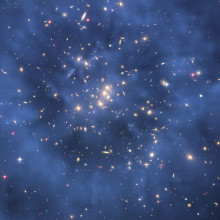
33:52 - Detecting dark matter at the LHC
Detecting dark matter at the LHC
Sarah Williams, University of Cambridge
One way physicists can better understand particles, and look for new species like the dark matter that Frank Close talked about, is to produce them in a lab. And one way to do that is by smashing together existing particles - like protons - at extremely high speeds. This can break them apart to reveal their constituents, and the behaviours of those constituents. Scientists doing this work famously say “you break it, make it, or shake it!” and this is what’s done at the CERN Large Hadron Collider - LHC, buried under Geneva. With the energies this 27 km long machine can harness, it can even recreate the conditions of the very early Universe, giving us insights into how key particles might have behaved at that time. Chris Smith spoke with Sarah Williams from the University of Cambridge, who works on one of the experiments at the LHC about their searches for dark matter...
Chris - Frank Close was just saying, Sarah, that we're now on the plains and that we need to strike out in search of that next mountain range, which is dark matter. You're part of the expeditionary force. Which way are you heading?
Sarah - That's actually one of the biggest challenges associated with this mission, in that while we know some of the characteristics we expect from dark matter, based on how it behaves in the Universe, there's actually a wealth of possible candidates. And that means that in order to maximise our chances of discovery, we have to systematically investigate all these possibilities. So I've been using the collisions in the ATLAS experiment at the LHC to search for new particles predicted in an extension of our current recipe book, the Standard Model, which is called Supersymmetry. This predicts that for every particle we currently know about, there's a heavier superpartner and introducing these new particles can actually solve several of the outstanding mysteries in our universe, including providing us a candidate for dark matter.
Chris - We can infer that dark matter is there, Sarah, when we look at distant galaxies and we can see the stars moving around in ways that can only be accounted for if there's something a lot heavier there, than what we can see. And that's how we worked out partly that it must be there. Given that, how are you trying to recreate something that's happening on the scale of galaxies in a particle accelerator?
Sarah - You're correct that what you're seeing in the Universe is the gravitational effects associated with large amounts of dark matter. However, we also expect that dark matter particles should have some weak interaction with particles in the Standard Model, like the protons that we're colliding in the LHC. And the nice thing about these LHC collisions is they happen so frequently - we're talking about colliding bunches of protons 40 million times a second - and that means that even if we'd only have very rare or weak interactions between the Standard Model particles and dark matter, in our very enormous data sets we might be able to see interesting hints that we've produced dark matter particles in these collisions. One of the problems, of course, with this is that actually when producing these very rare processes, it could also be mimicked by other processes that we already know about. So we have to be very careful with the design of our searches and also understand the known Standard Model processes very well.
Chris - So it's not that you can see the dark matter you're making. You are inferring that you're making it by onward domino effects on other particles, the way it interacts with other products of those collisions. And you can say, well, we would see that if dark matter is being made there and it fits our current theory for what it is.
Sarah - As you say, one of the big challenges with our experiments is, unfortunately, that a lot of these heavy particles we're trying to produce, and either discover with dark matter or now measure in the case of the Higgs particle, is that we can't just see them directly. So, most heavy particles would decay almost instantaneously, and then it's the particles they decay into that we're measuring. One of the challenges with dark matter is, as we said, because it would interact so weakly, it would actually not leave any visible signature in our detector if we were to produce it. So what we have to do is look at all the other particles that we produced in the collision and try to infer the possible existence of a dark matter particle being produced. It's a very challenging job, but one that with these very large data sets, we hope to be able to do.
Chris - Have you got anywhere yet? Are you seeing things that tantalisingly make you think you're on the right path across Frank Close's planes to that next mountain range? Or is it very much a wilderness at the moment?
Sarah - Unfortunately, one of the problems when embarking upon a journey where you don't know which way to go is that you have to be prepared to gather information about which paths are going to lead to fruition and which aren't. So, unfortunately, I've been working on the ATLAS experiment now for 10 years, where we've performed many searches for candidates of dark matter, and we haven't seen any signals yet. However, this information allows us to refine our future searches and gives us a better idea of where to look. And, actually, one of the exciting things at the moment is that when we start taking data again next year, we've got a few more years of data taking ahead of us, and we can use the lessons learnt so far to really design our searches to target some of the areas of possible dark matter space that could lead us to a discovery.
Chris - This is a horrible question - to say you have to answer this in 30 seconds, Sarah - but there are rival theories for what dark matter is. Are you considering all these theories or are you favouring just one when you're designing your experiments?
Sarah - Unfortunately, there is absolutely no way we could design a catch-all dark matter experiment. So we rely within the community of having complementary activities going on, some of which might be more sensitive to particular dark matter candidates and others that might be designed to target others. At the LHC, we're very good at targeting certain types of weakly-interacting dark matter particle. However, there are other well-known candidates that would require dedicated experiments, and also within high energy physics, there are others working on those, and I guess you could make up a whole hour or so discussing the different dark matter experiments if you wanted to.

40:16 - Measuring the magnetism of muons
Measuring the magnetism of muons
Brendan Casey, Fermilab
An experiment is attempting to answer the questions particle physics faces by trying to better quantify a particle discovered way back in the 1930s. This is the muon, a kind of heavy electron, and, earlier this year, researchers announced that in their experiments, muons did not appear to be following the pattern of behaviour we would predict if our theories about them are right. This sort of thing gets physicists very excited, because it means there’s potentially something new to be discovered. Chris Smith spoke with Brendan Casey from Fermilab’s Muon g-2 experiment, where these anomalies were uncovered, to find out more...
Chris - What's the experiment you've been doing?
Brendan - Our experiment is called the g-2 experiment, and what we're mainly trying to do is measure the magnetic strength of muons. This is an experiment people do every day around the world. Every time you pull a compass out of your pocket and look at which way the needle points, the needle points north. So, that's the same experiment we're doing, but we're doing it with muons. When we do this experiment with electrons, the compass points north, but when we do the experiment with muons, for some reason the needle is not pointing north. And so it's a huge mystery. It means there's something big out there which is turning the needle of muons, and it seems like it's just happening to muons. It's very strange. We have absolutely no idea what's going on, but we can reproduce it. We know it's happening.
Chris - And the point is, if something is not fitting the mould, there has to be a missing piece to this puzzle. And that missing piece could be what? A new force, a new particle? Something is making those muons buck the trend.
Brendan - Yes. I mean, it could be Bigfoot for all we know.
Chris - Hopefully not.
Brendan - With our experiments we measure muons and we could tell that something is bothering our muons. We can't tell what it is. We could tell it's something big. It could be something like dark matter - that's always our first guest, because we also don't know what dark matter is, but we really have no idea. There's no comprehensive model right now that can put together the things that we see at the LHC and the things that we're seeing at Fermilab with muons. So it's a ginormous mystery at this point.
Chris - Yes, we should mention that the LHC have also been studying muons in a bit of a different way, haven't they? Because when they do collisions, like Sarah Williams was just telling us, and they're looking at the products of those collisions, they know how many electrons they should get, they know how many muons they should get, and they don't get enough muons - something's going wrong. So there's something odd happening there. Do you think that's the same phenomenon that you're seeing, but from a different perspective, or do you think there's two new bits of physics going on?
Brendan - It could easily be the same thing. It could be that there's something big out there and it likes to knock muons around it Fermilab and it likes to gobble up muons at the LHC. When you see these two things, it's natural to try and put them together. There's no easy way to make them fit together right now, but it is absolutely tantalising that it's something happening in the muons. There's something out there and it's not happy with muons.
Chris - Theoretical physicist Ben Allanach told this programme earlier in the year that he's working on the possibility there might be a new fundamental force, a fifth force as it were, that could account for this, but equally he acknowledges dark matter could be responsible. If dark matter is doing this, Sarah Williams was telling us it's a struggle to detect dark matter, does this mean you've potentially got a way to find dark matter then? You could use muons as your torch in the darkness?
Brendan - Well, what we know is that the thing that we're seeing in muons is big, so it is a very important tool that we have for any model that people come up with. If they think it's dark matter, if they think it's Supersymmetry, if they think it's extra dimensions, all those things would have to make a prediction for how big of an effect would you see in the muons. And because we see such a large effect, it makes it this kind of bright candle that's sitting out there in the wilderness, that we have to be able to explain if we're going to be able to explain all these other things as well.
Chris - There may be people listening to this who are thinking, well, that's really interesting, but why does that matter to me as the average man or woman in the street. If you solve this - when you solve this - let's be optimistic, what's this going to change about our understanding of physics?
Brendan - It could revolutionise our understanding of physics. What you learn about physics in school and what you learn once you leave school, about the amount of the Universe that we can explain, is very large, right? So there's something revolutionary out there. And it's hard to say what it's going to look like when we're on the other side of that. We can't predict how it's going to change everyday lives. What we know is that once we understand it, we will never look at the Universe in the same way again.
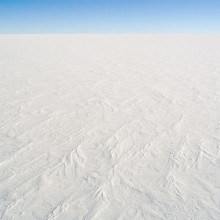
46:02 - IceCube: Antarctic neutrino telescope
IceCube: Antarctic neutrino telescope
Summer Blot, DESY
We’re going to switch tack slightly to talk about another mysterious type of particle, called a neutrino. Like an electron, but with no electrical charge and a very small mass, neutrinos are one of the most abundant particles in the universe. But, because they interact very little with matter, they are incredibly difficult to detect. Nevertheless, understanding them better might lead to some of the answers we’re looking for; but that means that researchers like Summer Blot sometimes need to go to extraordinary lengths to study them, as she told Eva Higginbotham...
Summer - So IceCube is the world's largest neutrino telescope, and it is super cool. It is actually buried into the glacier at the south pole in Antarctica
Eva - How does that work?
Summer - So neutrinos that are coming from let's say, extra terrestrial sources, or even neutrinos that are produced here on earth, they're kind of traveling through our bodies, but they're also traveling through this glacier. And so what we did with IceCube is we actually buried about 5,000 sensors down into the glacier. They start at about 1,500 metres under the surface, and then go down for another thousand metres, and basically these sensors instrument in total a cubic kilometre of ice. And what they do is they pick up the light signals that are produced when a neutrino naturally interacts in the glacier anyway
Eva - So you basically have a ginormous bit of ice that you've got light sensors in that you're using to pick up stuff coming from space?
Summer - Yeah. A cubic kilometre of ice to measure subatomic particles that are coming from many, many, many millions of light years away.
Eva - How do you go about putting the sensors 1,500 metres or whatever down into a glacier?
Summer - This is a great question, yes. There was actually a special drill that was built to build IceCube. And it works by heating up water and then shooting it super fast and in a very controlled way down into the glacier. So you basically melt the ice, deploy your sensors down into the hole that you've just melted, and then you leave the water in the hole and it sort of freezes back up so that your sensors are then literally frozen into the glacier itself
Eva - So what's the benefit of doing this in a glacier?
Summer - So the benefit is that the glacier just provides an incredibly large amount of matter for the neutrinos to interact with. The benefit for us is that the properties, the optical properties of the ice, are simply such that the light signals that neutrinos produce when they've interacted in the glacier, they can travel really, really far distances before they're absorbed in the ice itself. So that gives us the ability with our sensors to pick up more information, more and more of these light signals from the neutrino interactions with every single event that happens. So when the neutrino interacts in the ice and it tears apart the nucleus, it'll produce the shower of secondary particles and they travel along the same direction as the initial neutrino, and they're the ones producing this kind of bluish light. It's called Cherenkov radiation. And our sensors are basically instrumenting a three-dimensional grid in the ice, and so we basically sample this light as it's being produced along the trajectory of the secondary particles. Then we measure how much light was produced and when it was produced, that's what our sensors tell us, and we can therefore sort of track back and sort of trace back, okay, here there was a signal, and then after that there was a signal, and after that... And so you can kind of draw a line between it almost and say, ah, okay, so the neutrino must've been coming from that direction back there, and sort of point back up into the sky and say, is there anything there?
Eva - What's been found so far?
Summer - I'd say that sort of the most exciting thing is really just that these neutrinos coming from the cosmos do exist. So when we built IceCube we thought they were out there, we thought that all of our theories said, yeah, these neutrinos should be out there, but we hadn't actually discovered them until we built IceCube. And at this point in time we've detected enough of these neutrinos that it's pretty well established that they exist and that there are extra terrestrial sources of extremely high energy neutrinos. So what we still don't know is exactly, you know, how they're being produced or where they're being produced. And we have now some hints that they might be coming from certain types of galaxies with black holes in the centre, and a lot of dust and matter, and star formation going on in these galaxies, but we haven't really detected enough of neutrinos yet to say, definitively, yes, these neutrinos are coming from this kind of source and this is how they're being produced. The plan, what we hope to do is, to go from one cubic kilometre up to eight cubic kilometres inside of the ice, and then build an even larger array on the surface. This would basically allow us to detect even more neutrinos at even higher energies and really start to do, what I would say, is much more precise measurements of neutrino production in these very extreme distant sources
Eva - And have you been to IceCube?
Summer - Honestly, it's my favourite place on the planet. It's really unlike any place that I've been before, both in terms of just the sort of natural beauty, which it's just a very flat ice sheet, but somehow there's beauty in that - at least for me! But also in terms of just the kind of frontier spirit of, you know, a hundred people at a time, at most, living in a small sort of station, all working together for this one goal
Eva - It almost sounds like you could be going into space. I'm wondering, what do you eat there? What food is there?
Summer - So there's a greenhouse that during the winter can be used to grow fruits and veggies. Otherwise, a lot of really, really amazing food because - actually I think Anthony Bourdain did an episode once at the South Pole because the cuisine is so good. It's quite expensive to fly, well, let's say anybody or anything, to the South Pole. So the cost of the food then becomes negligible. So sometimes you're having lobster for dinner. Sometimes it's steak. Sometimes it's a beautiful cheese platter, you know, it's, it's actually really good food!
Eva - It's like you go somewhere so expensive that they'll only feed you really expensive things!

52:26 - QotW: Would a body in space decay?
QotW: Would a body in space decay?
Harry Lewis floated this one to Matthew Bothwell, public astronomer at Cambridge University. Fortnautely for us, Matt wasn't deterred by the sinister concept...
Daniel - If a crew on a mission to Mars had a death on board and the body was released into space, would that body ever decay?
Harry - Cue public astronomer, and close friend of The Naked Scientists, Matthew Bothwell from the University of Cambridge...
Matthew - What a cosmically creepy question! The answer is that no, a body exposed to the vacuum of space wouldn't decay in the way that bodies decay on Earth. In fact, in outer space, you'd ended up being preserved quite nicely. One important factor is that a body in space would dry out really quickly. The boiling temperature of liquids depends on the pressure, so lower pressure means a lower boiling point. In space where there's no pressure liquids just instantly boil, which means turn into gas. So a body ejected into vacuum would lose all its liquid quite quickly and become sort of mummified.
Harry - Similarly, if you were ejected into space without a spacesuit, after 14 seconds you'd experience the evaporation of water in your mouth. It would feel like an odd tingling sensation on the tongue.
Matthew - Another factor is that the lack of atmosphere makes space a hostile environment for bacteria. So a body in space wouldn't be broken down by bacteria in the same way that a body on earth would be. A lot of what we think of as a body decaying is the action of bacteria and that wouldn't be happening. One misconception about bodies in space is that people often think they would instantly freeze. This isn't true. You feel cold on earth when the atmosphere around you is at a low temperature. That is, the molecules in the gas around you have less energy than the molecules that make up your body, and so when the air hits your body it steals a bit of your energy and you cool down. But in space there's no atmosphere, and so you don't lose heat very effectively
Harry - Vacuums are really good at maintaining temperatures - just think about your thermos vacuum flask, capable of maintaining a constant temperature and allowing you to enjoy your coffee or soup hot later on in the day
Matthew - A body in space would freeze eventually, but it would have to freeze by losing heat radiation, which would take a lot longer than you might expect. So overall between the dehydration, the lack of bacteria, and the eventual freezing, a body in space would end up being very well preserved
Harry - Thanks for that Matt. You're drudging up memories of Battlestar Galactica there for me! Next week will be a tad closer to home whilst we endeavor to find out more for science teacher Ellie and one of her pupils...
Ellie - One of my students asked me a question that I couldn't answer..
Student - Hi Dr. Chris. I'm a Year 9 student from Manchester and I've got one blue eye and one brown eye. When I have kids, are they going to have a blue eye and a brown eye like me?










Comments
Add a comment